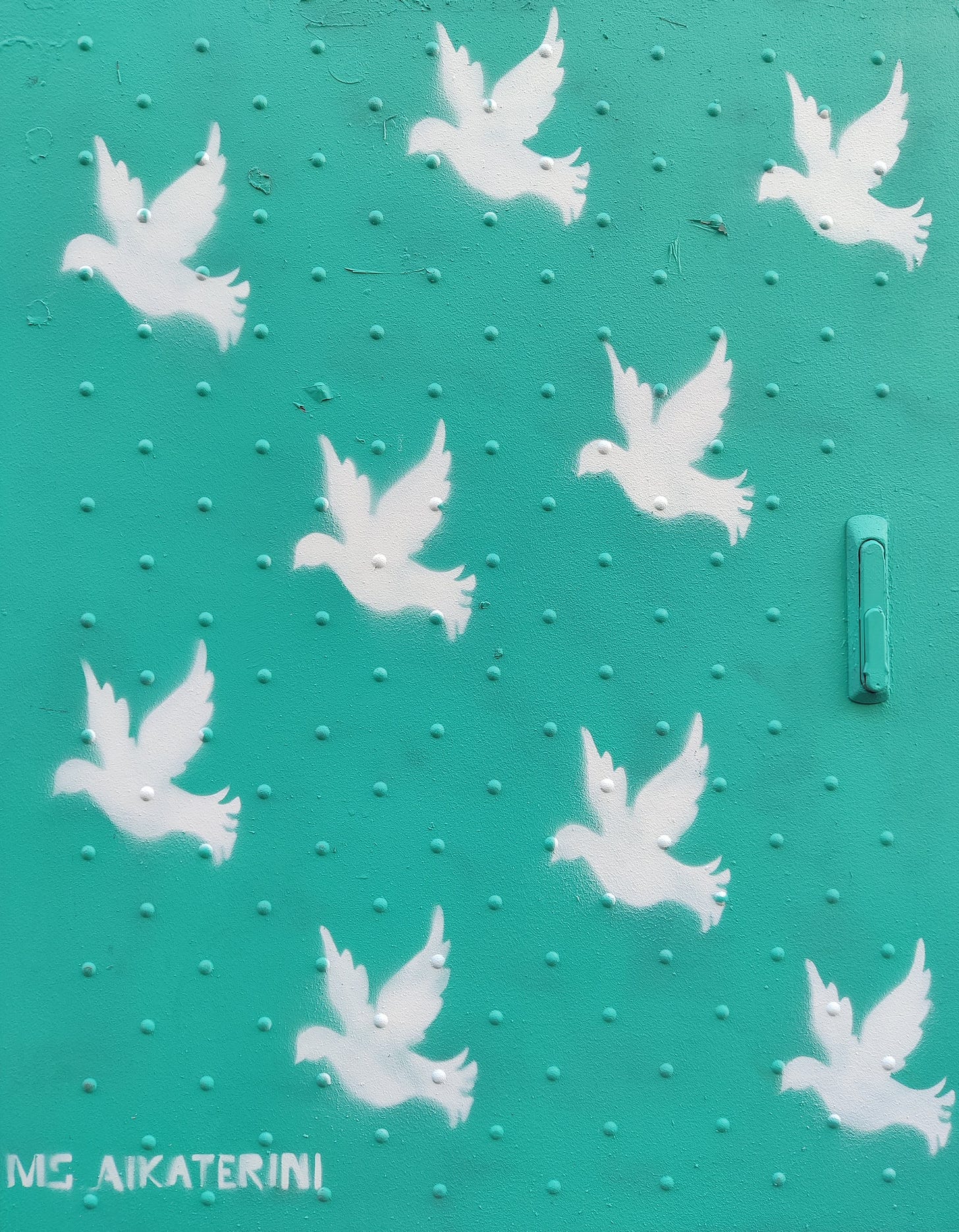Citizens vs. Industry: Part II
FOI documents provides context to the unravelling of Europe’s animal welfare reform
Last week, Thin Ink reached your inboxes late in the day (at least for those of you in Europe and Asia). This week, it’s arriving early! There’s a reason for this madness, I assure you.
I’m speaking at the Climate Arena Conference in Bologna this week. It’s a forum for journalists and scientists from across Europe who are investigating the climate crisis.
I’ll be on two panels: “Who decides what we eat?” which will focus on corporate consolidation in the food sector, and “Animal welfare as a climate issue” which I think is self-explanatory.
I wanted to publish this before the second talk, because I want to alert the journalists and scientists to the documents I’m sharing and get them interested in following up on what happened to the promised animal welfare reform in Europe.
After all, the industry may be powerful, but we are many, and like I said in a previous preamble, we need to form alliances among those of us who care about truth, our food systems, and our environment.
The Background
Almost exactly a year ago, I was involved in an investigation that tried to make sense of what happened to the package of animal welfare laws the European Commission had been working on.
The package was a result of participatory democracy in action.
Back in October, 2020, 1.4 million citizens from all over Europe asked the EU to end the practice of keeping farm animals in cages and increase their welfare standards. In June 2021, EU Parliament endorsed the request by an overwhelming majority and the European Commission decided to revise the current legislation in line with the citizens’ wishes.
The set of four laws were supposed to end practices such as keeping farm animals in cages, slaughtering day-old chicks, and the sale and production of fur.
Three years later, those promises were in tatters. All but one of the laws were dropped from the European Commission’s 2024 work programme, including the ban on caged farming.
The decision baffled animal rights activists but also ordinary observers, because a survey released in the same month as our investigation - and conducted at the height of inflation - found 84% of Europeans want more protection for animal welfare and 60% are even happy to pay more for it.
The Findings
In the course of our investigation, we discovered that aggressive lobbying against the laws by groups such as the European Livestock Voice (ELV) and its partner associations played a role in their demise.
ELV is a coalition of 14 livestock industry associations, including Copa-Cogeca, Europe’s most powerful farm lobby whom we also exposed last year. It was set up in 2019 “to bring back a balanced debate around a sector that is playing such an essential role in Europe’s rich heritage and future”.
Documents we received through freedom of information (FOI) requests showed that in at least six meetings between Sep 2021 and Feb 2023, ELV partner associations pushed DG SANTE, the branch of the commission tasked with drafting the animal welfare laws, to reconsider ending caged farming. One asked “the Commission to resist the pressure from NGOs”, saying, “NGO perspectives do not reflect the views of the broad public/ the society.”
Sources told us that EFSA, the European Food Safety Authority, which published a total of 11 scientific opinions relating to animal welfare between August 2022 and May 2023, came under particular criticism. In its opinions, EFSA recommended, among other things, more space, lower temperatures, and shorter journeys to improve animal welfare during transport. It was also against mutilation, feed restriction and the use of cages for broiler chickens and laying hens.
I wrote about the findings in more detail in the issue linked below. I also wrote at the time that “it is anyone’s guess when or if (the laws) will appear in the future”. We’re still guessing.
The New Files
During our investigation last year, we sent FOI requests to EFSA to better understand the pressure they came under from livestock industry groups. These were done under a regulation that allows anyone residing in an EU member state to ask for public access to European Parliament, Council and Commission documents.
Earlier this year, we received two separate batches of documents totalling 27 files. These include:
Two joint letters from industry associations directed to DG SANTE and cc-ed to EFSA. These were sent between Nov 2022 and Apr 2023 (more on these below).
Five documents relating to the poultry sector.
Six documents relating to the foie gras sector.
13 documents relating to farm animal breeding sector.
The communications range from an invitation to EFSA to attend farm visits and working group meetings to feedback and recommendations on EFSA’s scientific opinions.
The Joint Letters
The ones that made my spider sense tingle the most are the two joint letters.
1. One letter, dated Nov 18, 2022, is on general animal welfare and submitted by AVEC Poultry on behalf of “several European associations along the livestock value chain”, which, according to the attached 53-page document, included nine organisations, eight of which are ELV members.
The document criticised EFSA’s consultation process as “unclear”, that the recommendations “reflect a lack of understanding of modern breeding goals and programs”, and suggested the legislation is being developed in an unrealistic way.
The following pages are full of rebuttals and criticisms.
In one particular instance relating to haemoglobin levels of calves where EFSA suggested measures based on a precautionary principle, the industry said, “It is not the EFSA mandate to invoke the precautionary principle and substitute to the risk manager. The mandate of EFSA should be to report what present practices are and what the science says and, in the present case, science is not sufficient.”
On another recommendation to prevent injuries to domestic birds, the industry said, “This seems to be inflammatory content.”
Harsh or warranted? I suggest you take a look. Below are some screenshots. Highlights are mine.
2. Another 50-page document, dated April 14, 2023, relates to EFSA’s scientific options on the welfare of broilers and was submitted by three organisations, including AVEC.
The letter said the organisations “would like to draw (the Commission’s) attention to some serious concerns we have for the opinion both in general terms, but also on the scientific approach to arrive at specific recommendations made by EFSA.”
It again criticised the consultation process as unclear and not transparent and the arguments and documents used in the scientific opinion as “selective and misrepresented data and thus being questionable from a scientific standpoint”.
It also chided EFSA experts for overlooking facts and providing estimates that “conflict with reality”, and said some recommendations were “putting in danger EU food security”.
There were specific inputs from Portugal and France on pages 46 - 48 for anyone interested in them.
The Reason(s) for Sharing
Animal welfare is a topic of public interest and I believe people have a right to know the arguments the industry was making to push back on a subject that has overwhelming public support.
Are the rebuttals part of a normal, robust scientific discourse or attempts to undermine the science the industry disagrees with? A few people to whom I’ve shown some of the arguments say they are significantly more combative than the normal industry documents, but I’d like others with more knowledge and experience to make this judgement.
The documents could be handy for other journalists who are following up on the legislation.
Thin’s Pickings
Myanmar's Absent Soil Stewards - Myaelatt Athan/ Earth Journalism Network
Harry Ko’s deeply-reported story about how the country’s soils are rapidly degrading under the strain of climate change, illegal mining and political upheaval.
It shows the wide-ranging and heartbreaking - but little-reported - impacts of political instability beyond the civil war.
Full disclosure: I helped Harry and local news outlet Myaelatt Athan (meaning “voice of central Myanmar”) to realise this story as part of Earth Journalism Network’s Ground Truths project.The price we pay for manure - Long Play
An investigation on why Europe is (literally) in deep shit: farm animals in the EU produce over a billion tonnes of manure annually, and just 4% of European farms generate 80% of the continent’s manure.This page explains and breaks down the problem and there’s a list of published stories at the bottom by news outlets in Germany, the Netherlands, Finland, and Sweden.
A U.N. Official’s Payments: Zero Interest Loans, a Mercedes and a Tennis Sponsorship - The New York Times
Wild story about how a high-ranking U.N. official lost $58 million of his agency’s money after entrusting them all to a British businessman who also showered him with gifts, including a $1.2 million sponsorship for the official’s teenage son.
Poison PR: The Secret Network Keeping Harmful Herbicides On Sale - 1 & 2
Powerful two-part documentary from the Africa Uncensoed team as part of the Poison PR investigation (read my recent issue on the findings).
As always, please feel free to share this post and send tips and thoughts on bluesky @thinink.bsky.social, mastodon @ThinInk@journa.host, my LinkedIn page, twitter @thinink, or via e-mail thin@thin-ink.net.













Excellent overview of what happened, thank you. The Commission legislative proposals were ready last year, well prepared by DG SANTE. In view of EP elections, and designation of the Commission President, there were put in the fridge, most likely under order of the Cabinet if the now redesignated Commission President. Fears of farmers anger, cost of new investments, risk of food price rise have stopped everything but the proposal on animal transport. The key issue of the cage ban is the one which would improve animal welfare and which corresponds to citizen concern. But nobody knows when it will come back on the agenda…